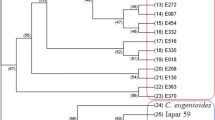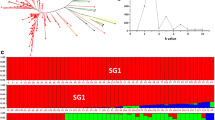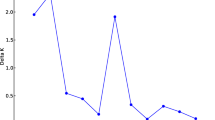Abstract
The knowledge of population structure is important to determine the degree of linkage disequilibrium, which allows the selection of genotypes for association mapping. Using 47 SSR markers, the genetic variability and population structure of 68 accessions of C. arabica (wild and cultivated) and of three diploid species used as reference were evaluated. The analysis was done with the distance method and the structure model. The structure analysis inferred nine subpopulations (k = 9), for which the greatest values of probability were obtained. Three of the groups corresponded to the three diploid species as expected. There were six groups identified within C. arabica. The genetic subdivisions within C. arabica were based on geographical origin, degree of domestication, and dispersal history of coffee. One group consisted entirely of cultivated genotypes, where intense population bottleneck were associated with a founder effect. This was the most homogeneous group, as demonstrated by the reduced distance between cultivars in the dendrogram. Three of the cultivated genotypes, originating from Sudan, were separated into an independent group, presumably due to selective adaptation to a different set of environmental conditions. Another group consisted of genotypes of the type “ennarea” that were grown and cultivated in isolation on the shores of the Tana lake. The semi-wild genotypes clustered into three different groups. This type of analysis provides a strong evidence of population structure in C. arabica. Based on these findings, it is possible to better identify a balanced sample of diverse plants in germplasm.



Similar content being viewed by others
References
Anthony F, Berthaud J, Guillaument JL, Lourd M (1987) Collecting wild Coffea species in Kenya and Tanzania. Plant Genet Resour News 169:23–29
Anthony F, Combes MC, Astorga DCG, Bertrand B, Graziosi G, Lashermes P (2002) The origin of cultivated Coffea arabica L. varieties revealed by AFLP and SSR markers. Theor Appl Gen (Alemania) 104(5):894–900, 36 Refs
Bernatzky R, Tanksley SD (1986) Toward a saturated linkage map in tomato based on isozymes and random cDNA sequences. Genetics 112:887–898
Berthaud J, Charrier A (1988) Genetic resources of Coffea. In: Clarke RJ, Macrae R (eds) Coffee vol. 4: agronomy. Elsevier, London, pp 1–42
Carvalho A (1946) Distribuiçäo geografica e classificaçäo botánica do gênero Coffea com referência especial à espécie Arabica. V origem e classificaçäo botánica do C. arabica L. Bol Super Serv Caf 21:174–180
Carvalho A (1952) Taxonomia de Coffea arabica L. Caracteres morfologicos dos haploides. Bragantia 12:201–212
Chevalier A, Dagron M (1928) Recherches historiques sur les débuts de la culture du caféier en Amerique. Commun Actes Acad Sci Colonial Paris
Eskes AB (1989) Identification, description and collection of coffee types in P.D.R. Yemen. IPGRI, Rome
Fernie, L.M. FAO Coffee survey in Ethiopia. In: FAO Coffee Mission to Ethiopia, 1964–1968. Roma (Italia), FAO, 1968. p. 6–31
Goncalves MM, Rodrigues ML (1976) Estudos sobre o café de Timor. II. Nota sobre as possibilidades de producao do Híbrido de Timor no seu habitat natural. Lisboa (Portugal), MEAU. p. 31–72. Port. (Comunicacoes No. 86)
Grassias M, Kammacher P (1975) Observations sur la conjugaison chromosomique de Coffea arabica L. Café Cacao Thé 19:177–190
Haarer AF (1956) Modern coffee production. Leonard Hill, London
Jones PA (1956) Notes on the varieties of Coffea arabica in Kenya. In: SELECTED articles on coffee culture; a bibliography and selected articles from the Coffee Board of Kenya Monthly Bulletin 1935–1956. Ruiru. Kenya Coffee (Kenya) 21(251):305–309
Lashermes P, Cros J, Combes MC, Trouslot P, Anthony F, Hamon S, Charrier A (1996) Inheritance and restriction fragment length polymorphism of chloroplast DNA in the genus Coffea L. Theor Appl Genet 93:626–632
Lashermes P, Combes MC, Robert J, Trouslot P, D’Hont A, Anthony F, Charrier A (1999) Molecular characterization and origin of the Coffea arabica L. genome. Mol Gen Genet 261:259–266
Lashermes P, Paczek V, Trouslot P, Combes MC, Couturon E, Charrier A (2000) Single-locus inheritance in the allotetraploid Coffea arabica L. and interspecific hybrid C. arabica x C. canephora. J Hered 91:81–85
Lejeune JBH (1958) Rapport au Gouvernement Impérial d’Ethiopie sur la production caféière. FAO, Rome
Liu K, Muse SV (2005) PowerMarker integrated analysis environment for genetic marker data. Bioinformatics 21(9):2128–2129
Meyer FG (1968) FAO coffee mission to Ethiopia 1964–1965 Report. FAO, Rome
Moncada MDP, McCouch SR (2004) Simple sequence repeat diversity in diploid and tetraploid Coffea species. Genome (Canadá) 47:501–509
Montoya CJC, Moncada MDP, Mendoza FGA, Lopez GGA (2006) Optimización y caracterización de SSRs en una muestra del banco de germoplasma de Coffea de Cenicafé. Fitotecnia Colombiana (Colombia) 6(2):44–51
Nei M (1972) Genetic distance between populations. Amer Naturalist 106:283–292
Orozco-Castillo C, Chalmers KJ, Waugh R, Powell W (1994) Detection of genetic diversity and selective gene introgression in coffee using RAPD markers. Theor Appl Genet 87:934–940
Pritchard JK, Stephen M, Donnelly P (2000) Inference of population structure using multilocus genotype data. Genetics 155:945–959
Rosemberg NA (2002) Distruct: a program for the graphical display of structure results. http://www.cmb.usc.edu/~noahr/distruct.html
Rosemberg NA (2004) Distruct: a program for the graphical display of structure results. Molecular Ecology Notes 4:137–138
Rovelli P, Mettulio R, Anthony F, Anzueto F, Lashermes P, Graziosi G (2000) Microsatellites in Coffea arabica. In: Sera T, Soccol CR, Pandey A, Roussos S (eds) Coffee biotechnology and quality: 123–133. Kluwer, Dordrecht
Semon M, Nielsen R, Jones M, McCouch S (2005) The population structure of African cultivated rice Oryza Glaberrima (Steud.): evidence for elevated levels of LD caused by admixture with O. sativa and ecological adaptation. Genetics 169:1639–1647
Smith RF (1985) A history of coffee. In: Clifford MN, Wilson KC (eds) Coffee botany, biochemistry and production of beans and beverage. Croom Helm, London Sydney, pp 1–12
Sneath PHA, Sokal RR (1973) Numerical Taxonomy. W. H. Freeman, San Francisco, CA
Sylvain PG (1955) Some observations on Coffea arabica L. in Ethiopia. Turrialba 5:37–53
Thomas AS (1942) The wild arabica coffee on the Boma Plateau. Anglo-Egyptian Sudan. Emp Exp Agric 10:207–212
Vega FE, Eric R, Collins W (2003) Global project needed to tackle coffee crisis. Nature 425:343
Wellman FL (1961) Coffee, botany, cultivatiotn and utilization. Leonard Hill, London
Acknowledgments
The authors want to thank the Ministry of Agriculture of Colombia for financing this work; to the collaborators in Cenicafe’s lab for extraction of DNA samples and to Yong Gu Cho and Sandra Harrigton at Cornell University for helping us with lab protocols and data analysis.
Author information
Authors and Affiliations
Corresponding author
Additional information
Communicated by D. Grattapaglia
Rights and permissions
About this article
Cite this article
López-Gartner, G., Cortina, H., McCouch, S.R. et al. Analysis of genetic structure in a sample of coffee (Coffea arabica L.) using fluorescent SSR markers. Tree Genetics & Genomes 5, 435–446 (2009). https://doi.org/10.1007/s11295-008-0197-2
Received:
Revised:
Accepted:
Published:
Issue Date:
DOI: https://doi.org/10.1007/s11295-008-0197-2




